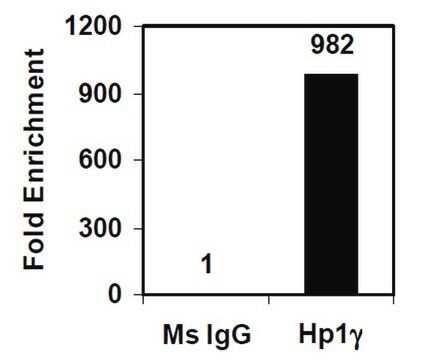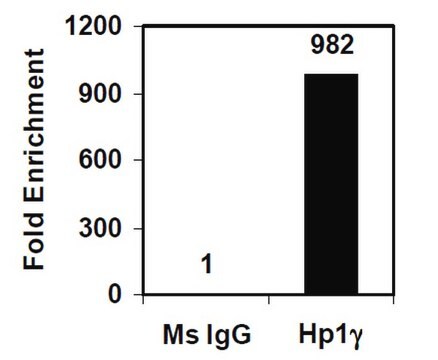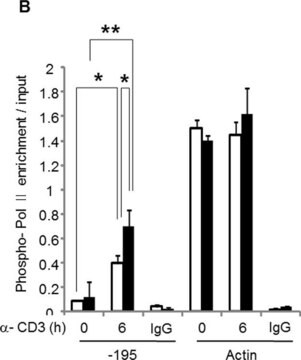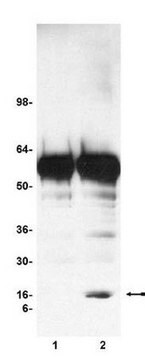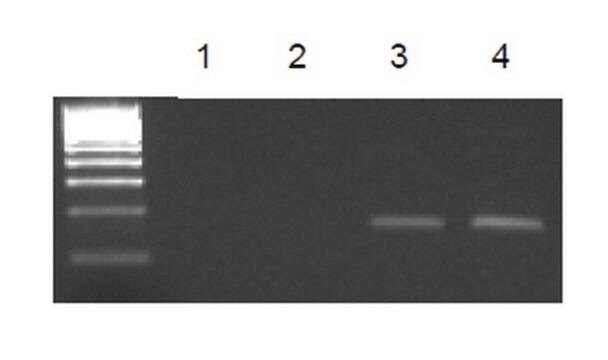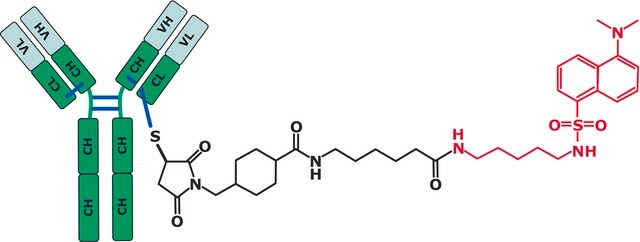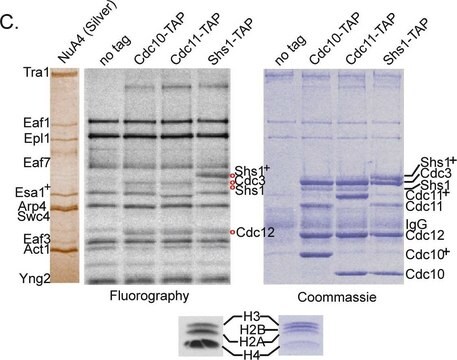推荐产品
一般說明
All ChIPAb+ antibodies are individually validated for chromatin precipitation, every lot, every time. Each ChIPAb+ antibody set includes control primers (tested every lot by qPCR) to biologically validate your IP results in a locus-specific context. The qPCR protocol and primer sequences are provided, allowing researchers to validate ChIP protocols when using our antibody in their chromatin context. Each set also includes a negative control antibody to ensure specificity of the ChIP reaction.
The ChIPAb+ Histone H3 (C-term) set includes the Histone H3 (C-term) antibody, a negative control supernatant (rabbit), and qPCR primers which amplify a 110 bp region of human β-Globin. The Histone H3 (C-term) and negative controls are supplied in a scalable "per ChIP" reaction size and can be used to functionally validate the precipitation of Histone H3-associated chromatin.
The ChIPAb+ Histone H3 (C-term) set includes the Histone H3 (C-term) antibody, a negative control supernatant (rabbit), and qPCR primers which amplify a 110 bp region of human β-Globin. The Histone H3 (C-term) and negative controls are supplied in a scalable "per ChIP" reaction size and can be used to functionally validate the precipitation of Histone H3-associated chromatin.
Histone H3 is one of the five main histone proteins involved in the structure of chromatin in eukaryotic cells. Featuring a main globular domain and a long N-terminal tail, H3 is involved with the structure of the nucleosomes of the ′beads on a string′ structure. Histone proteins are highly post-translationally modified, and Histone H3 is the most extensively modified of the five histones. The term "Histone H3" alone is purposely ambiguous in that it does not distinguish between sequence variants or modification state. Histone H3 is an important protein in the emerging field of epigenetics, where its sequence variants and variable modification states are thought to play a role in the dynamic and long term regulation of genes.
特異性
Broad species cross-reactivity expected due to sequence homology.
Recognizes Histone H3 near the C-terminus.
免疫原
Epitope: C-Terminus
KLH-conjugated, synthetic peptide corres-ponding to the C-terminus of human Histone H3.
應用
Chromatin Immunoprecipitation:
Sonicated chromatin prepared from HeLa cells (1 X 106 cell equivalents per IP) were subjected to chromatin immunoprecipitation using 4 µL of a negative control supernatant, or 4 µL of Anti-Histone H3 (C-term) and the Magna ChIP® A Kit (Cat. # 17-610).
Successful immunoprecipitation of Histone H3 associated DNA fragments was verified by qPCR using ChIP Primers, β-Globin as well as GAPDH promoter primers. (Please see figures). Data is presented as percent input of each IP sample relative to input chromatin for each amplicon and ChIP sample as indicated.
Please refer to the EZ-Magna ChIP A (Cat. # 17-408) or EZ-ChIP (Cat. # 17-371) protocol for experimental details.
Western Blot Analysis:
Representative Lot Data.
Acid extracts from colcemid treated HeLa cells were resolved by electrophoresis, transferred to nitrocellulose and probed with anti-Histone H3 (C-term) (1:1000 dilution).
Proteins were visualized using a goat anti-rabbit secondary antibody conjugated to HRP and a chemiluminescence detection system. (Please see figures).
Western Blot Analysis:
Representative lot data.
Acid extracted proteins from HeLa cells untreated (Lane 1), colcemid treated (Lane 2). HeLa nuclear extracts (Lane 3), acid extracted HeLa cells treated with sodium butyrate (Lane 4), untreated (Lane 5) and unmodified recombinant Histone H3 (Lane 6) were resolved by electrophoresis, transferred to nitrocellulose and probed with a previous lot of anti-Histone H3 (C-term) (1:5000 dilution).
Proteins were visualized using a goat anti-rabbit secondary antibody conjugated to HRP and a chemiluminescence detection system. (Please see figures).
Sonicated chromatin prepared from HeLa cells (1 X 106 cell equivalents per IP) were subjected to chromatin immunoprecipitation using 4 µL of a negative control supernatant, or 4 µL of Anti-Histone H3 (C-term) and the Magna ChIP® A Kit (Cat. # 17-610).
Successful immunoprecipitation of Histone H3 associated DNA fragments was verified by qPCR using ChIP Primers, β-Globin as well as GAPDH promoter primers. (Please see figures). Data is presented as percent input of each IP sample relative to input chromatin for each amplicon and ChIP sample as indicated.
Please refer to the EZ-Magna ChIP A (Cat. # 17-408) or EZ-ChIP (Cat. # 17-371) protocol for experimental details.
Western Blot Analysis:
Representative Lot Data.
Acid extracts from colcemid treated HeLa cells were resolved by electrophoresis, transferred to nitrocellulose and probed with anti-Histone H3 (C-term) (1:1000 dilution).
Proteins were visualized using a goat anti-rabbit secondary antibody conjugated to HRP and a chemiluminescence detection system. (Please see figures).
Western Blot Analysis:
Representative lot data.
Acid extracted proteins from HeLa cells untreated (Lane 1), colcemid treated (Lane 2). HeLa nuclear extracts (Lane 3), acid extracted HeLa cells treated with sodium butyrate (Lane 4), untreated (Lane 5) and unmodified recombinant Histone H3 (Lane 6) were resolved by electrophoresis, transferred to nitrocellulose and probed with a previous lot of anti-Histone H3 (C-term) (1:5000 dilution).
Proteins were visualized using a goat anti-rabbit secondary antibody conjugated to HRP and a chemiluminescence detection system. (Please see figures).
Research Category
Epigenetics & Nuclear Function
Epigenetics & Nuclear Function
Research Sub Category
Histones
Histones
This ChIPAb+ Histone H3 (C-term) -ChIP Validated Antibody & Primer Set conveniently includes the antibody & the specific control PCR primers.
包裝
25 assays per set. Recommended use: ~4 μL of antibody per chromatin immunoprecipitation (dependent upon biological context).
品質
Chromatin Immunoprecipitation:
Sonicated chromatin prepared from HeLa cells (1 X 106 cell equivalents per IP) were subjected to chromatin immunoprecipitation using 4 µL of either Negative Control Supernatant or 4 µL of Anti-Histone H3 (C-term) and the Magna ChIP® A Kit (Cat. # 17-610). Successful immunoprecipitation of Histone H3 associated DNA fragments was verified by qPCR using ChIP Primers, β-Globin (Please see figures).
Please refer to the EZ-Magna ChIP A (Cat. # 17-408) or EZ-ChIP (Cat. # 17-371) protocol for experimental details.
Sonicated chromatin prepared from HeLa cells (1 X 106 cell equivalents per IP) were subjected to chromatin immunoprecipitation using 4 µL of either Negative Control Supernatant or 4 µL of Anti-Histone H3 (C-term) and the Magna ChIP® A Kit (Cat. # 17-610). Successful immunoprecipitation of Histone H3 associated DNA fragments was verified by qPCR using ChIP Primers, β-Globin (Please see figures).
Please refer to the EZ-Magna ChIP A (Cat. # 17-408) or EZ-ChIP (Cat. # 17-371) protocol for experimental details.
標靶描述
~17 kda
外觀
Anti-Histone H3 (C-term) (rabbit monoclonal IgG). One vial containing 100 µL of cultured supernatant in 0.05% sodium azide. Store at -20°C.
Negative Control Supernatant (rabbit). One vial containing 100 µL of cultured supernatant in 0.05% sodium azide. Store at -20°C.
ChIP Primers, β-Globin.
One vial containing 75 μL of 5 μM of each primer specific for human β-Globin. Store at -20°C.
FOR: AGG ACA GGT ACG GCT GTC ATC
REV: TTT ATG CCC AGC CCT GGC TC
Negative Control Supernatant (rabbit). One vial containing 100 µL of cultured supernatant in 0.05% sodium azide. Store at -20°C.
ChIP Primers, β-Globin.
One vial containing 75 μL of 5 μM of each primer specific for human β-Globin. Store at -20°C.
FOR: AGG ACA GGT ACG GCT GTC ATC
REV: TTT ATG CCC AGC CCT GGC TC
儲存和穩定性
Stable for 1 year at -20°C from date of receipt. Handling Recommendations: Upon first thaw, and prior to removing the cap, centrifuge the vial and gently mix the solution. Aliquot into microcentrifuge tubes and store at -20°C. Avoid repeated freeze/thaw cycles, which may damage IgG and affect product performance.
分析報告
Control
Includes negative control supernatant (rabbit) and primers specific for human β-Globin.
Includes negative control supernatant (rabbit) and primers specific for human β-Globin.
法律資訊
MAGNA CHIP is a registered trademark of Merck KGaA, Darmstadt, Germany
UPSTATE is a registered trademark of Merck KGaA, Darmstadt, Germany
免責聲明
Unless otherwise stated in our catalog or other company documentation accompanying the product(s), our products are intended for research use only and are not to be used for any other purpose, which includes but is not limited to, unauthorized commercial uses, in vitro diagnostic uses, ex vivo or in vivo therapeutic uses or any type of consumption or application to humans or animals.
儲存類別代碼
10 - Combustible liquids
Stylianos Poulios et al.
Cells, 10(4) (2021-05-01)
Histone acetylation is directly related to gene expression. In yeast, the acetyltransferase general control nonderepressible-5 (GCN5) targets histone H3 and associates with transcriptional co-activators alteration/deficiency in activation-2 (ADA2) and alteration/deficiency in activation-3 (ADA3) in complexes like SAGA. Arabidopsis thaliana has
Judy A Brusslan et al.
PloS one, 7(3), e33151-e33151 (2012-03-20)
Leaf senescence is the orderly dismantling of older tissue that allows recycling of nutrients to developing portions of the plant and is accompanied by major changes in gene expression. Histone modifications correlate to levels of gene expression, and this study
Carol D Curtis et al.
Molecular and cellular biology, 32(7), 1312-1320 (2012-02-01)
Canonical Wnt signaling plays an important role in embryonic and postnatal blood vessel development. We previously reported that the chromatin-remodeling enzyme BRG1 promotes vascular Wnt signaling. Vascular deletion of Brg1 results in aberrant yolk sac blood vessel morphology, which is
Reema B Davis et al.
Development (Cambridge, England), 140(6), 1272-1281 (2013-02-15)
Arteries and veins acquire distinct molecular identities prior to the onset of embryonic blood circulation, and their specification is crucial for vascular development. The transcription factor COUP-TFII currently functions at the top of a signaling pathway governing venous fate. It
Xavier Brenachot et al.
Molecular metabolism, 3(6), 619-629 (2014-08-28)
Overfeeding causes rapid synaptic remodeling in hypothalamus feeding circuits. Polysialylation of cell surface molecules is a key step in this neuronal rewiring and allows normalization of food intake. Here we examined the role of hypothalamic polysialylation in the long-term maintenance
我们的科学家团队拥有各种研究领域经验,包括生命科学、材料科学、化学合成、色谱、分析及许多其他领域.
联系技术服务部门